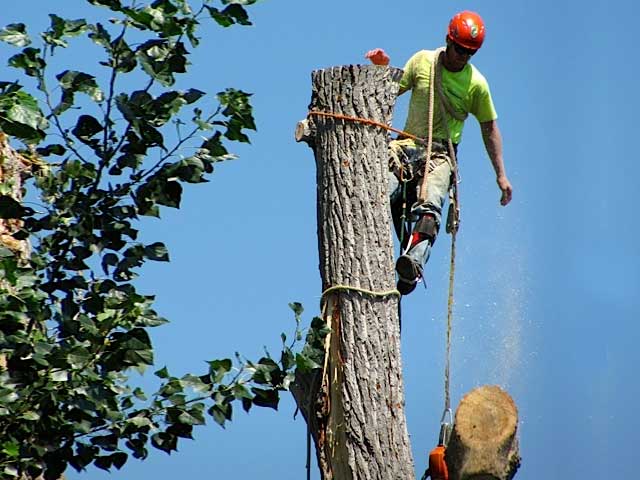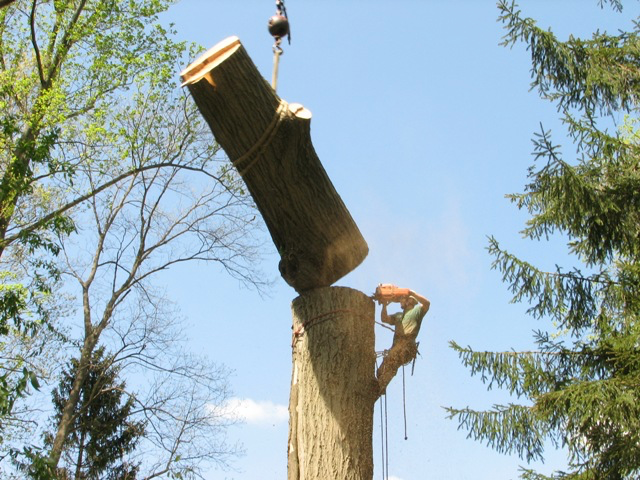Removing tree stumps

A tree is quickly felled, but to remove a tree stump you need a lot of strength and the right technique, the right machine or just enough time. We explain the different possibilities.
He didn’t have a tree or two in his garden that he had to part with at some point with a heavy heart? Spruces in particular often become a problem – they grow higher and higher, but are not very stable, so that you have to worry about the roof of your house during a storm. Once the old tree has been removed, however, part of the problem has been solved. What remains is the tree stump: it can only be removed from large trees with heavy equipment such as a stump grinder. If you choose another, less violent way, a root needs at least eight to ten years, depending on the tree species, until it has rotted to such an extent that the remains can be easily removed.
Excavating a tree stump to save energy
Trees with weak and flat roots like spruce, tree of life and cypress can still be dug out by hand up to a trunk diameter of about 30 centimetres. Of course, this is primarily a question of physical fitness, but also of the right technique: Leave a piece of the trunk at least 1.50 metres long and dig out the roots all around with a sharp spade. Thinner roots should be pierced while digging, thicker ones should be cut with a sharp axe. Important: Take out a good spade-width piece from each stronger root so that it does not obstruct further digging.
As soon as you have cut the larger roots, use the rest of the trunk as a lever and push it alternately in different directions. The remaining roots will tear off and you can remove the stump from the hole. If the root system is too heavy, you should first remove the soil with a spade or a sharp jet of water. Tip: If you want to remove an entire hedge, a winch or a pulley block is very helpful. The devices are simply attached with the other end to the next, still fixed trunk. In this way you can exert considerably more force and the roots tear off more easily. If you have completely dug out the tree root, it is also interesting for garden design again – for example as decoration for a heather garden or a shadow bed.
Burn out tree stumps
However, it is not advisable to burn out tree stumps. With this often recommended procedure, some large and deep holes should be drilled vertically or at a slight angle from the outside to the inside of the stump. Then a mixture of saltpeter (sodium nitrate) and petroleum is mixed to a tough paste and filled into the holes. The mixture is then ignited, resulting in a smouldering fire that burns the inside of the tree stump. However, practical experience has shown that this usually only works inadequately: There is always charred residue left, which rots badly due to the charcoal coating. This method should also be rejected for reasons of environmental and climate protection: A lot of smoke is produced and the petroleum can contaminate the entire soil if used incorrectly. Versions with diesel or fuel paste are also extremely dangerous and harmful to the environment.

Accelerate natural decomposition
It takes many years to let a tree stump weather and rot in a natural way. However, there are possibilities to help a little. For example, you can speed up rotting by sawing the stump to the ground with a chainsaw or by drilling a few deep holes in close proximity with a large wood drill. Then fill the grooves or holes with plenty of semi-decayed compost, which you have previously mixed with some compost accelerator or organic fertilizer. The compost contains countless fungal spores and other microorganisms that will soon decompose the still fresh wood. Since the wood body provides only little nutrients, you should support the microscopically small helpers every spring with a few handfuls of organic fertilizer.
Alternatively, you can also fill the holes with calcium cyanamide, a mineral nitrogen fertilizer – it also supplies the microorganisms with vital nitrogen. This is the active ingredient of the frequently offered preparation “Wurzel-Ex”. As a normal calcium cyanamide fertilizer, however, it is much cheaper and has the same effect. Under favourable conditions, the tree stump decomposes after one year to such an extent that it can be smashed with the blunt side of an axe.
If none of the methods described can be used to remove the stump, you should simply integrate it into your garden. For example, you can use it with a beautiful climbing plant or as a stand for a feeding box, a bird bath or a planted flower bowl.
Visit https://treeremovalnorthyork.com/ for certified tree removal services in Greater Toronto.

